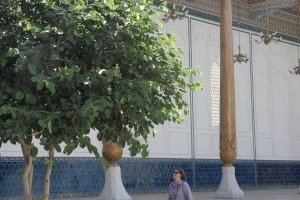Uzbekistan
Bahoutdin Architectural Complex
Site Info
Official Information
- Full Name
- Bahoutdin Architectural Complex (ID: 5306)
- Country
- Uzbekistan
- Status
-
On tentative list 2008
Site history
History of Bahoutdin Architectural Complex
- 2008: Added to Tentative List
- Added to tentative list
- Type
- Cultural
- Criteria
Links
- UNESCO
- whc.unesco.org
All Links
UNESCO.org
- whc.unesco.org — whc.unesco.org
Community Information
- Community Category
- Religious structure: Islamic
- Secular structure: Burial
Travel Information
Recent Connections
News
No news.
Community Reviews
Show full reviews
Uzbekistan is an unmissable destination for any serious traveller, mainly for its monumental and well-preserved architectural heritage. Next to the famous higlights such as Samarkand and Bukhara, there are a number of lesser known sights that I would not hesitate to propose to for example a “Missing Top 50 Asia” list. One of those is the Bahoutdin Complex, a group of Sufi funeral and religious monuments some 10 km outside of the city of Bukhara.
Bahoutdin Naqshaband was a 14th century Sufi saint. He was the founder of the Naqshbandi order, and was considered the spiritual patron of Bukhara governors. His order became influential as far as India, Dagestan (Russia), Syria, Egypt and China. Therefore, his tomb remains the most esteemed in Uzbekistan and attracts visitors from other Islamic countries as well. It apparently is nicknamed "Mecca of Central Asia".
The tomb is part of a large memorial and religious complex, with constructions from different periods in time starting from 1544. The complex has been renovated in 1993 with Turkish and Pakistani funding, after it had been abandoned during Soviet times. When I visited (in May 2010) it was busy with Uzbek pilgrims. I was prepared to cover my arms, legs and head here due to the site’s religious nature - but many of the Uzbek women also walked around with short sleeves and without a headscarf.
The complex surrounding Bahoutdin’s mausoleum is large. After entering through the monumental gate, one first passes the rows and rows …
Keep reading 0 comments
